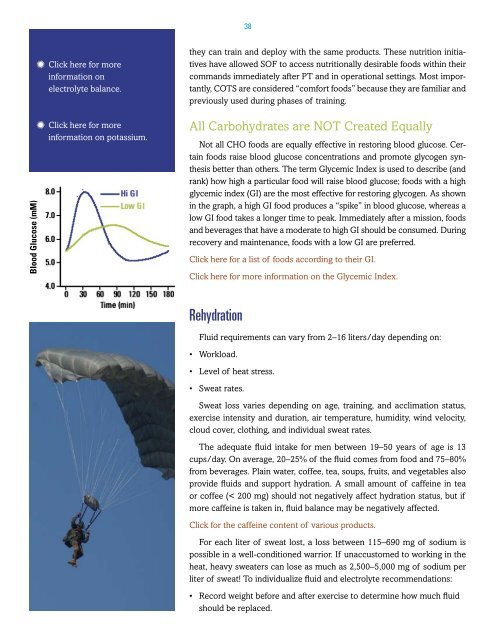special-operations-nutrition-guide
special-operations-nutrition-guide
special-operations-nutrition-guide
Create successful ePaper yourself
Turn your PDF publications into a flip-book with our unique Google optimized e-Paper software.
38<br />
Blood Glucose (mM)<br />
= =Click here for more<br />
information on<br />
electrolyte balance.<br />
= =Click here for more<br />
information on potassium.<br />
they can train and deploy with the same products. These <strong>nutrition</strong> initiatives<br />
have allowed SOF to access <strong>nutrition</strong>ally desirable foods within their<br />
commands immediately after PT and in operational settings. Most importantly,<br />
COTS are considered “comfort foods” because they are familiar and<br />
previously used during phases of training.<br />
All Carbohydrates are NOT Created Equally<br />
Not all CHO foods are equally effective in restoring blood glucose. Certain<br />
foods raise blood glucose concentrations and promote glycogen synthesis<br />
better than others. The term Glycemic Index is used to describe (and<br />
rank) how high a particular food will raise blood glucose; foods with a high<br />
glycemic index (GI) are the most effective for restoring glycogen. As shown<br />
in the graph, a high GI food produces a “spike” in blood glucose, whereas a<br />
low GI food takes a longer time to peak. Immediately after a mission, foods<br />
and beverages that have a moderate to high GI should be consumed. During<br />
recovery and maintenance, foods with a low GI are preferred.<br />
Click here for a list of foods according to their GI.<br />
Click here for more information on the Glycemic Index.<br />
Rehydration<br />
Fluid requirements can vary from 2–16 liters/day depending on:<br />
• Workload.<br />
• Level of heat stress.<br />
• Sweat rates.<br />
Sweat loss varies depending on age, training, and acclimation status,<br />
exercise intensity and duration, air temperature, humidity, wind velocity,<br />
cloud cover, clothing, and individual sweat rates.<br />
The adequate fluid intake for men between 19–50 years of age is 13<br />
cups/day. On average, 20–25% of the fluid comes from food and 75–80%<br />
from beverages. Plain water, coffee, tea, soups, fruits, and vegetables also<br />
provide fluids and support hydration. A small amount of caffeine in tea<br />
or coffee (< 200 mg) should not negatively affect hydration status, but if<br />
more caffeine is taken in, fluid balance may be negatively affected.<br />
Click for the caffeine content of various products.<br />
For each liter of sweat lost, a loss between 115–690 mg of sodium is<br />
possible in a well-conditioned warrior. If unaccustomed to working in the<br />
heat, heavy sweaters can lose as much as 2,500–5,000 mg of sodium per<br />
liter of sweat! To individualize fluid and electrolyte recommendations:<br />
• Record weight before and after exercise to determine how much fluid<br />
should be replaced.


